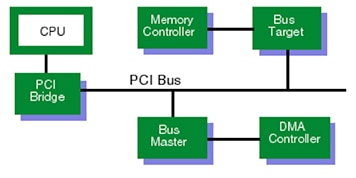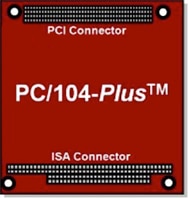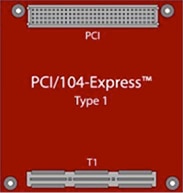Next-Generation PC104 Form Factor For IoT SBCs
資料提供者:DigiKey 歐洲編輯群
2016-07-13
Single-Board Computers (SBCs) have provided a convenient means of building smart devices for a wide range of applications across sectors such as industry, media, healthcare and communications.
Development has concentrated on a variety of standardized form factors, such as Mini-ITX, EBX and PC/104, which take advantage of established standards in terms of hardware and software development to bring economies of scale from the desktop PC market into the embedded world.
The first-generation PC/104 standard was built around the PC ISA bus, and incorporated a single 104-pin expansion connector that allows developers to introduce extra functions on the ISA bus by stacking multiple boards to create a computing subsystem that incorporates all the features to meet their exact requirements. The 90 mm x 96 mm PC/104 form factor has become widely recognized and adopted by embedded system designers needing a compact solution that provides high performance and can be quickly customized.

Figure 1: PC resources connected to the PCI Express bus, as in a single-board computer.
As the desktop PC has advanced rapidly, driven by catalysts such as the Internet and desktop multimedia, processor performance and functional integration have traced swift upward trends. Bus standards also have evolved in response to market demands for greater performance, in the case of PCI, and lower pin count in the case of LPC (Low Pin-Count) bus and PCI-Express (Figure 1). As the SBC industry has sought to deliver these performance improvements to embedded developers, new board formats have emerged that standardize support for the later bus standards. Typical examples include PC/104-Plus™ with PCI bus and ISA connectors (Figure 2a), and PCI/104-Express that supports PCI and PCI Express (Figure 2b).

Figure 2a: PC/104-Plus added support for the higher-performing PCI bus within the PC/104 form factor.

Figure 2b: Full support for PCI Express has replaced the ISA connector in later PC/104 standards.
On PCI/104-Express boards, PCI Express replaces the ISA bus. The PCI-Express Type 1 connector is positioned in the location formerly occupied by the ISA connector. SBCs supporting these later standards have adopted progressively faster and more feature-rich PC processors, such as the Intel® Celeron® and Atom® families. The combination of processor and bus advancements has driven SBC capabilities forward at a fast pace.
New demands on SBCs
More recently, the growing prevalence of Internet of Things (IoT) applications has begun to shift the balance of power. New SBC variants and smaller form factors, such as the Raspberry Pi and BeagleBoard SBCs based on ARM® processors and open-source Linux distributions, are arriving in the marketplace that cater to demands for lower cost, lower power consumption, and rich I/O. These types of boards are less oriented towards high processing and data-transfer speeds, and more towards providing large numbers of channels, low to moderate bandwidth, and support for a diverse range of standards.
Standards such as the PC/104 series have continued to evolve to address IoT applications that require moderate processing performance and I/O, such as connected industrial controls, smart vending machines, or intelligent transportation infrastructure. In particular, formats that provide full support for PCI Express allow users to configure a channel of up to sixteen lanes. Although this ensures support for high-performance graphics or intensive data transfers, developers can often satisfy any graphics and data-heavy demands using the processor resources. The PC/104 Consortium found that full support for PCI Express was often unused.
Such changes in usage have driven the emergence of the latest PCIe/104 OneBank® standard. OneBank removes two of the three PCI Express banks, which has allowed the standard 156-pin PCI Express connector to be replaced with a 52-pin connector in the bottom-left position corresponding to Bank One of the standard PCIe/104 connector. This allows backwards compatibility with legacy PCI/104-Express and PCIe/104 modules, and has also saved about 0.5 in2 of board space. On the other hand, although PCI Express support has been reduced to four x1 lanes, faster Gen 3 speeds provide plentiful bandwidth for many industrial monitoring and control applications.
SBCs that support the latest OneBank standard include the Versalogic Bengal series of SBCs such as the VL-EPME-30EAP, which provides native USB3.0, USB2.0, SPI, SATA and dual-Ethernet connectivity on the board. There are also eighteen 3.3 V digital I/Os. Single-, dual- or quad-core Intel Atom processor options are available. The main connectivity can be extended as required, by stacking additional PCIe/104 modules using the OneBank connector. These may be off-the-shelf modules, or custom boards brought up to satisfy individual I/O requirements. The OneBank connector gives developers versatile and cost-effective options to expand the computing system to meet the needs of their application. A project may require large numbers of analog I/Os in an industrial or environmental monitoring application. On the other hand, wireless connectivity may be needed, or a cellular connection in the case of a remote IoT device installed in a location where no other infrastructure is available.
The stackable nature of the PC/104 standards allows multiple boards to be added if necessary to provide the full required connectivity. Most PC/104 projects use either one or two stacked boards, according to information from the PC/104 Consortium. The Bengal VL-EPME-30EAP SBC consumes only 5.5 W in idle and 7.5 W maximum dynamic power, operating from a 5 V supply.
Another way to customize SBC I/O
If the project requires extra I/O to be added, bringing up a custom stacking module that is capable of handling the I/O without adding to the load on the processor can impose complex design challenges. Digi International provides an alternative approach with SBCs, such as the Rabbit BL4S110, by integrating the Rabbit RIO intelligent I/O processor on the board. The RIO IC has eight independent functional blocks with four outputs that can be configured as bi-directional I/Os or peripheral functions such as PWM generation, edge- or level-based interrupts, signal capture/counting, or quadrature decoding. As an intelligent I/O subsystem, this device allows developers to use the SBC’s 40 MHz Rabbit 4000 processor for control tasks, data processing and communications.
In addition to the resources provided by the Rabbit RIO, the BL4S110 has an integrated XBee® ZigBee® PRO RF module on-board, as well as 10Base-T Ethernet, thereby allowing ZigBee-to-Ethernet gateway functionality. There is also a built-in web server, which enables web pages to control ZigBee-enabled networks using ZigBee AT and API command libraries. In addition, the BL4S110 provides two RS-232 serial ports, eight analog inputs and twenty digital I/O lines. These I/O and control capabilities can be implemented without adding expansion cards. The board footprint is mid-way between the PC/104 and EBX footprints, measuring 96 mm x 146 mm.
Conclusion
Advances in PC-processor performance and integration, combined with growing demand for distributed intelligence in resource- and power-constrained IoT endpoints, has enabled a new generation of single-board computers to emerge. Developers who are familiar with PC/104 can address such opportunities and continue to take advantage of their investment in the form factor, using boards such as VersaLogic’s Bengal PCIe/104 OneBank series. The Rabbit RIO configurable intelligent IC introduces a different approach to demands for I/O-rich connected applications.

聲明:各作者及/或論壇參與者於本網站所發表之意見、理念和觀點,概不反映 DigiKey 的意見、理念和觀點,亦非 DigiKey 的正式原則。






